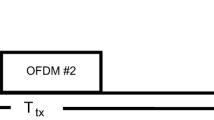Abstract
The goal of this paper is to improve the data rate in a multiple user (MU) underwater system. Toward this goal, we propose a new modulation, a combination of hyperbolic frequency modulation (HFM) and power frequency modulation (PFM) signals. By overlapping the heterogeneous signals, the number of bits which can be transferred during a symbol duration increase. In addition, by finely dividing the bandwidth into sub-channels, we increase the size of available modulation order per each user. Owing to the Doppler invariant characteristic of HFM signal, the Doppler shift can be estimated and it is utilized to compensate for the Doppler distortion occurred at the PFM signal. To take acoustic channel properties into account the system evaluation, we develop an acoustic network simulator involving well-defined propagation physics. The simulation results substantiate that our modulation scheme significantly increases data rate as compared with the existing MU systems.
















Similar content being viewed by others
References
Akyildiz, I. F., Pompili, D., & Melodia, T. (2005). Underwater acoustic sensor networks: Research challenges. Ad Hoc Networks, 13(52), 257–279.
Jiang, Z. (2008). Underwater acoustic networks-issues and solutions. International Journal of Intelligent Control and Systems, 13(3), 152–161.
Stojanovic, M., & Freitag, L. (2013). Recent trends in underwater acoustic communications. Marine Technology Society Journal, 47(5), 45–50.
Zhu, Y., Peng, Z., Cui, J. H., & Chen, H. (2015). Toward practical MAC design for underwater acoustic networks. IEEE Transactions on Mobile Computing, 14(4), 872–886.
Chen, K., Ma, M., Cheng, E., Yuan, F., & Su, W. (2014). A survey on MAC protocols for underwater wireless sensor networks. IEEE Communication Surveys and Tutorials, 16(3), 1433–1447.
Sozer, E. M., Stojanovic, M., & Proakis, J. G. (2000). Underwater acoustic networks. IEEE Journal of Oceanic Engineering, 25(1), 72–83.
Pompili, D., Melodia, T., & Akyildiz, I. F. (2009). A CDMA-based medium access control for underwater acoustic sensor networks. IEEE Transactions on Wireless Communications, 8(4), 1899–1909.
Shen, H., & Suppappola, A. P. (2006). Diversity and channel estimation using time-varying signals and time-frequency techniques. IEEE Transactions on Signal Processing, 54(9), 3400–3413.
Zhou, M., Zhang, J. J., & Suppappola, A. P. (2014). Hyperbolic frequency modulation for multiple users in underwater acoustic communications. In 2014 IEEE international conference on acoustics, speech and signal processing (ICASSP), pp. 3498–3502.
Khan, M. A., Rao, R. K. & Wang, X. (2013). Non-linear trigonometric and hyperbolic chirps in multiuser spread spectrum communication systems. In IEEE 9th international conference on emerging technologies (ICET, pp. 3400–3413.
Song, X., Willett, P., & Zhou, S. (2012). Range bias modeling for hyperbolic-frequency-modulated waveforms in target tracking. IEEE Journal of Oceanic Engineering, 37(4), 670–679.
Stojanovic, M., & Preisig, J. (2009). Underwater acoustic communication channels: Propagation models and statistical. Communications Magazine, 47(1), 84–89.
Heritage, J. P., Thurston, R. N., Tomlinson, W. J., Weiner, A. M., & Stolen, R. H. (1985). Spectral windowing of frequency-modulated optical pulses in a grating compressor. Applied Physics Letters, 47(2), 87–89.
Han, S. H., & Lee, J. H. (2005). An overview of peak-to-average power ratio reduction techniques for multicarrier transmission. IEEE Wireless Communications, 12(2), 56–65.
Yang, J., & Sarkar, T. K. (2007). A novel doppler-tolerant polyphase codes for pulse compression based on hyperbolic frequency modulation. Digital Signal Processing, 17(6), 1019–1029.
Shen, H., & Suppappola, A. P. (2007). Dynamic configuration of time-varying waveforms for agile sensing and tracking in clutter. IEEE Transactions on Signal Processing, 55(7), 3207–3217.
Diamant, R., Feuer, A., & Lampe, L. (2012). Choosing the right signal: Doppler shift estimation for underwater acoustic signals. In Sensors and transducers, pp. 1174–1179.
Ramezani, H., & Leus, G. (2012). Ranging in an underwater medium with multiple isogradient sound speed profile layers. Sensors, 12(3), 2996–3017.
Stojanovic, M. (2007). On the relationship between capacity and distance in an underwater acoustic communication channel. In ACM SIGMOBILE mobile computing and communications review, pp. 34–43.
Qarabaqi, P., & Stojanovic, M. (2013). Statistical characterization and computationally efficient modeling of a class of underwater acoustic communication channels. IEEE Journal of Oceanic Engineering, 38(4), 701–717.
Galvin, R., & Coats, R. E. W. (1996). A stochastic underwater acoustic channel model. In MTS/IEEE oceans, pp. 203–210.
Chitre, M. (2007). A high-frequency warm shallow water acoustic communications channel model and measurements. The Journal of the Acoustical Society of America, 122(5), 2580–2586.
Zhang, J., Cross, J., & Zheng, Y. R. (2010) Statistical channel modeling of wireless shallow water acoustic communications from experiment data. In Proceedings of military communication conference, pp. 2412–2416) (2010).
Hodges, R. P. (2010). Underwater acoustics: Analysis, design and performance of sonar (p. 2010). New York: Wiley.
WAFO. (2011). A Matlab toolbox for analysis of random waves and loads, tutorial for WAFO v2.5. Lund Univ., Lund, Sweden [Online]. http://www.maths.lth.se/matstat/wafo.
Lee, H., Kim, T. H., Choi, J. W., & Choi, S. (2015). Chirp signal-based aerial acoustic communication for smart devices. In IEEE conference on computer communications (INFOCOM), pp. 2407–2415.
Funding
This work (2016R1A2B4016588) was supported by Mid-career Researcher Program through NRF grant funded by the MEST.
Author information
Authors and Affiliations
Corresponding author
Additional information
Publisher’s Note
Springer Nature remains neutral with regard to jurisdictional claims in published maps and institutional affiliations.
Rights and permissions
About this article
Cite this article
Kim, S., Yoo, Y. Practical Multiple User System Using Heterogeneous Frequency Modulation for High Data Rate in Underwater Sensor Network. Wireless Pers Commun 108, 1393–1416 (2019). https://doi.org/10.1007/s11277-019-06475-y
Published:
Issue Date:
DOI: https://doi.org/10.1007/s11277-019-06475-y




